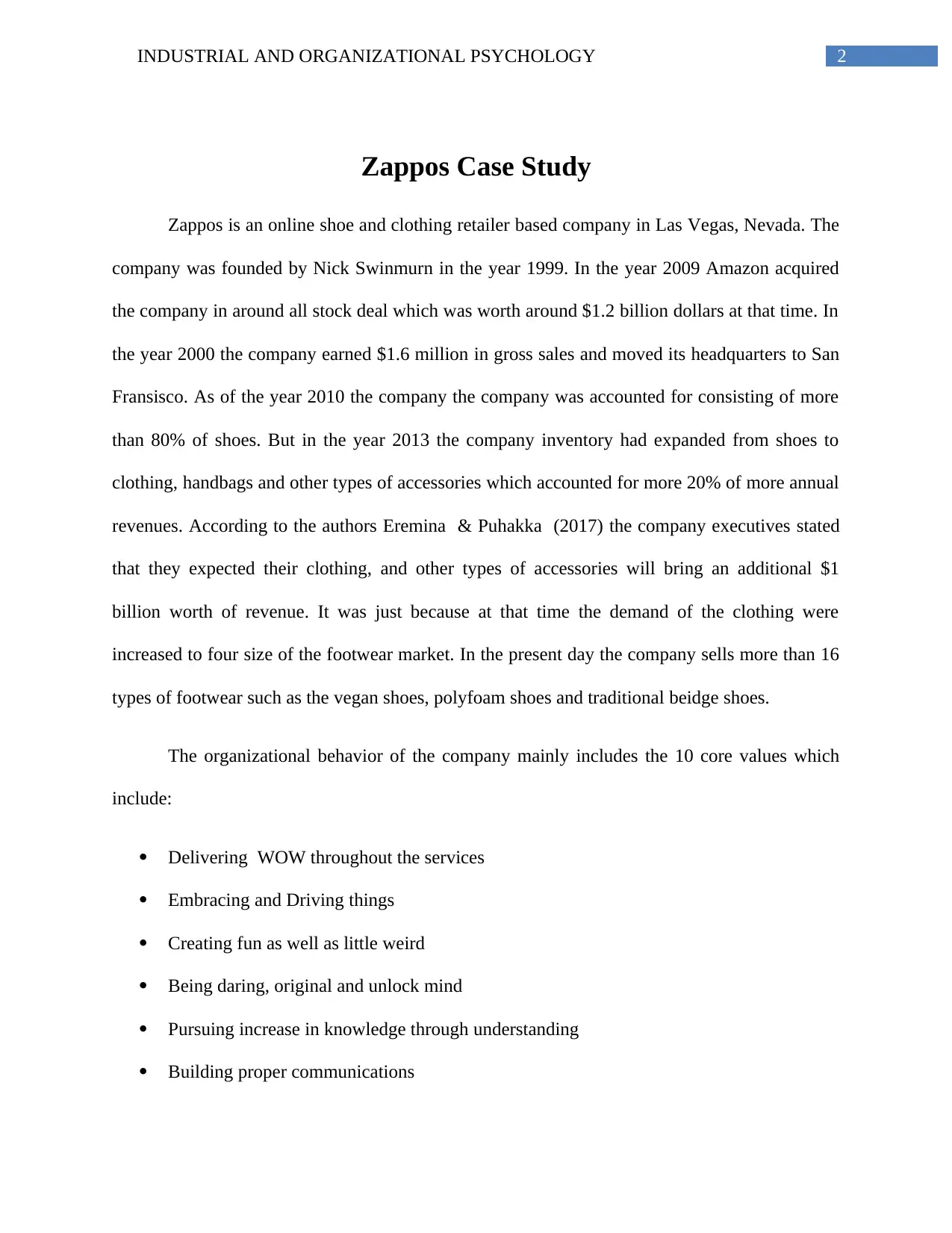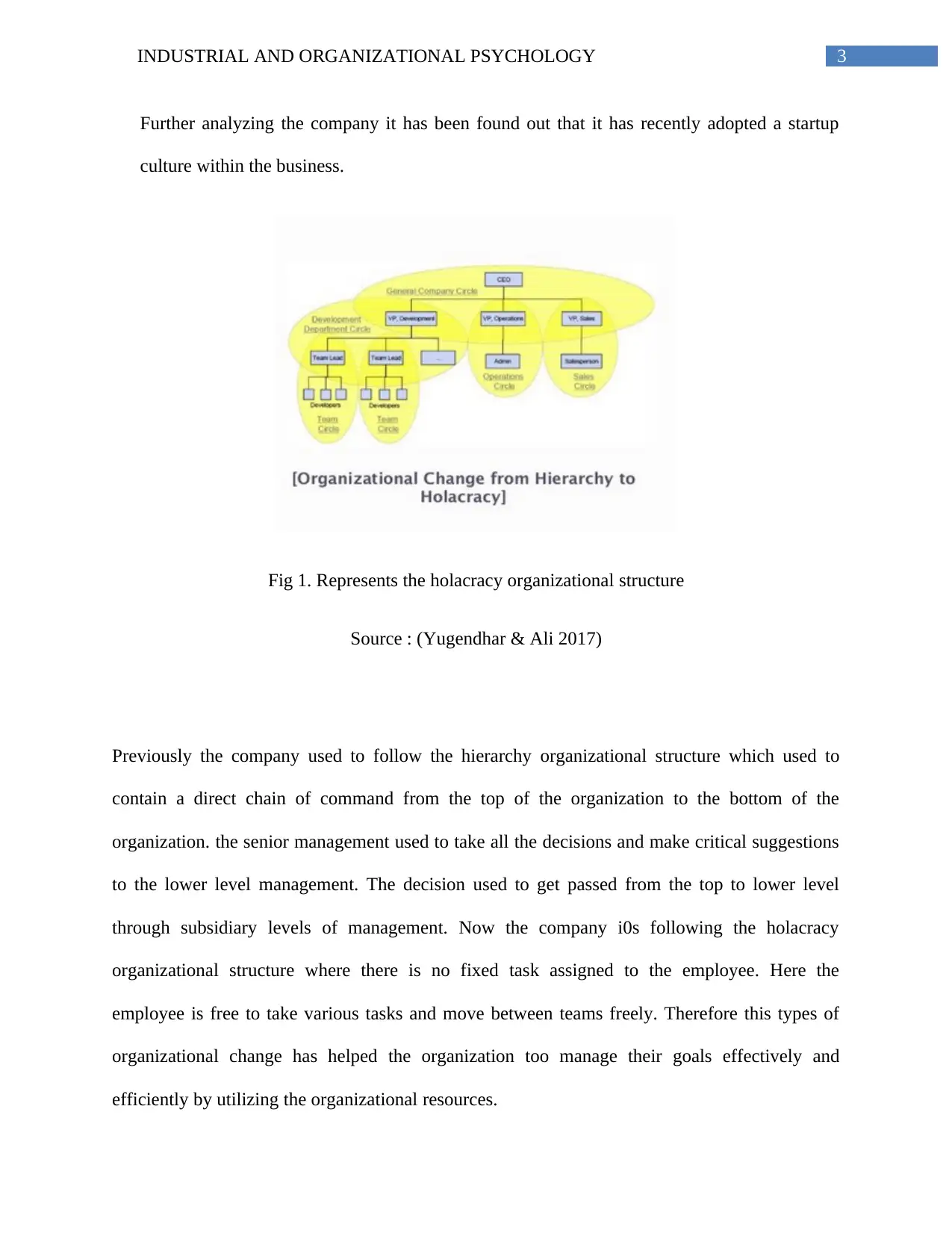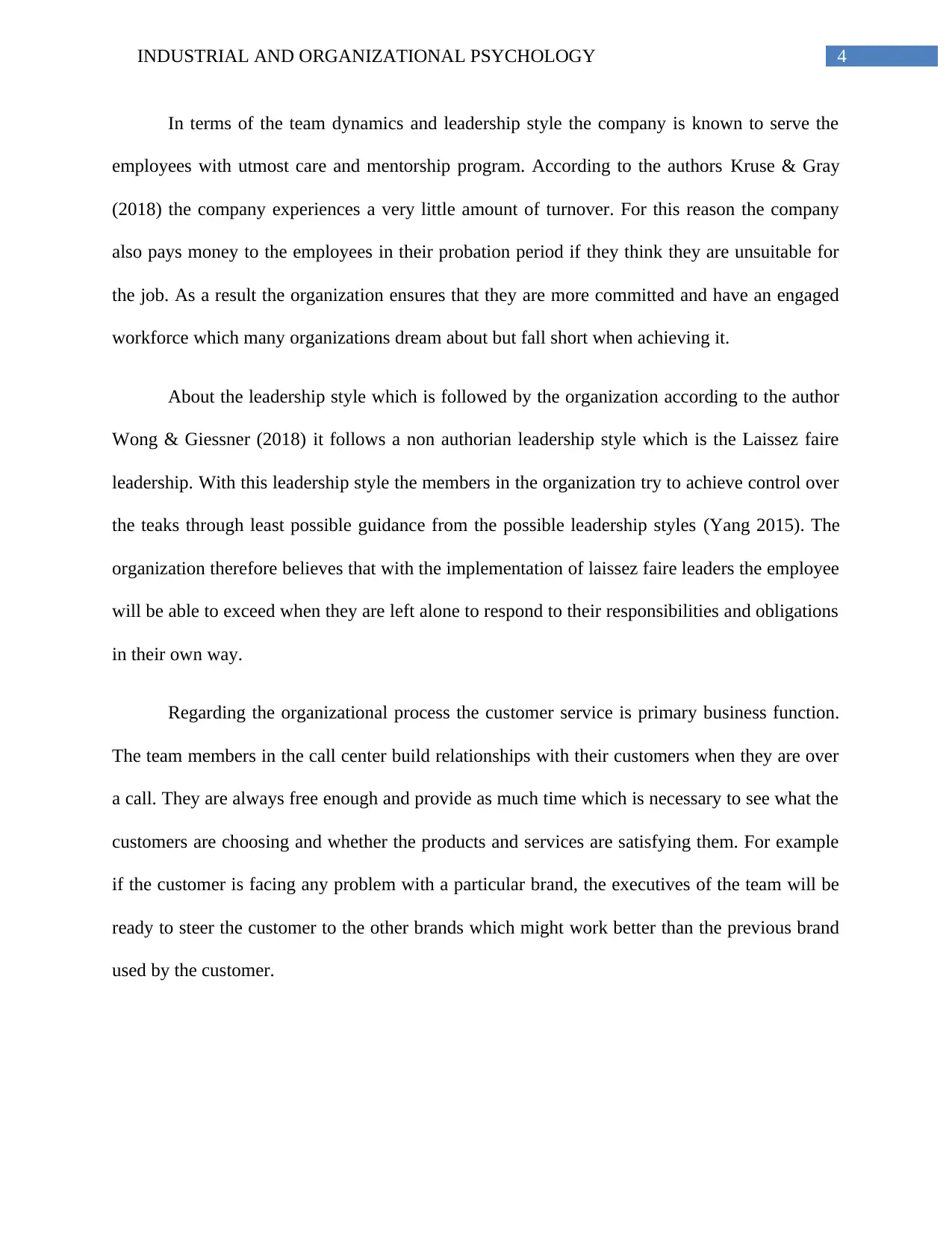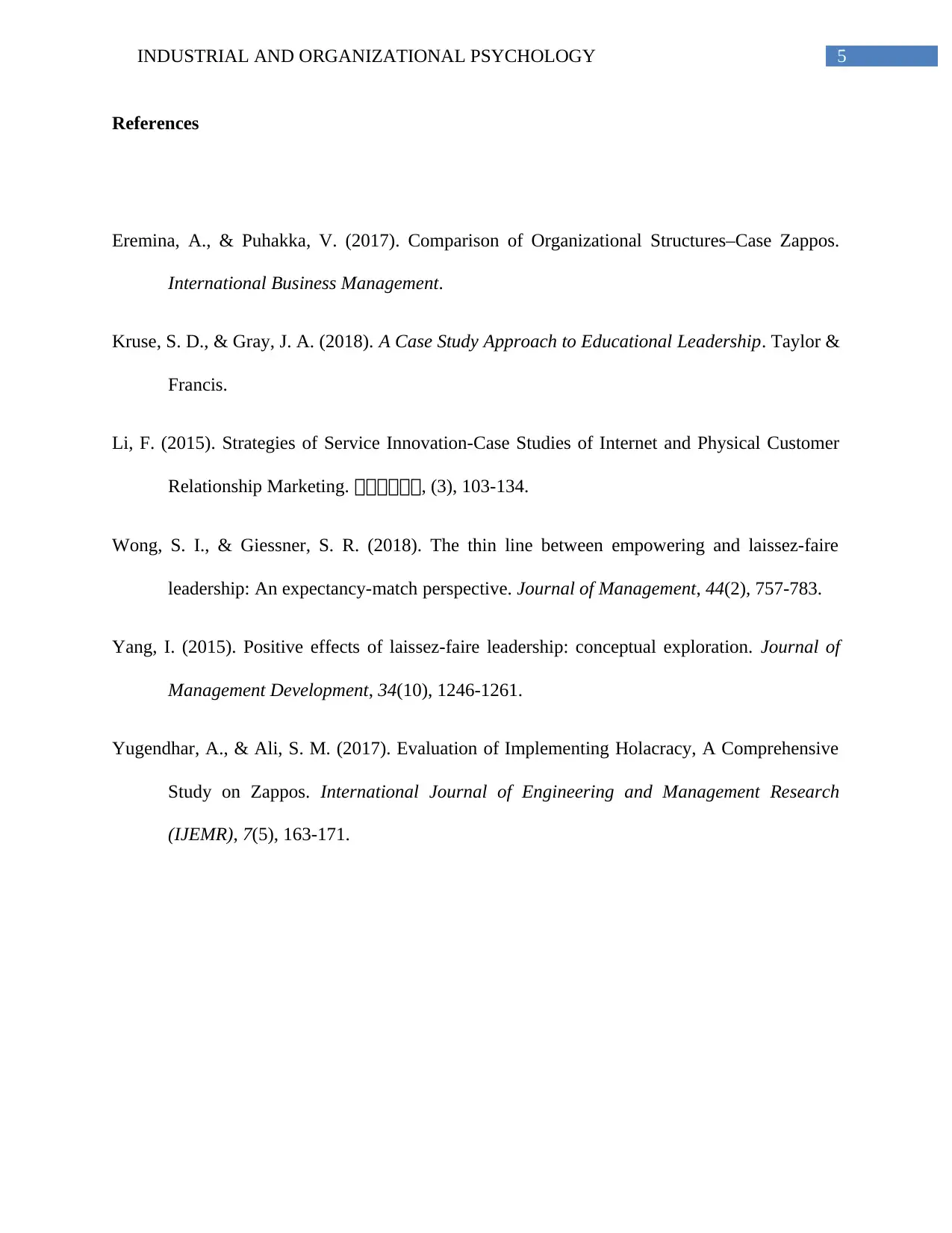Industrial and Organizational Psychology: Zappos Case Study Analysis
VerifiedAdded on 2022/11/16
|5
|940
|208
Case Study
AI Summary
This case study examines Zappos, an online retailer, through the lens of Industrial and Organizational Psychology. It analyzes Zappos' organizational behavior, including its 10 core values and its shift from a hierarchical to a holacracy organizational structure. The study explores the company's team dynamics, leadership style (specifically, laissez-faire leadership), and its focus on employee engagement and customer service. The analysis highlights how Zappos aims to create a positive work environment and deliver exceptional customer experiences. The case study references several academic articles to support its claims, providing a comprehensive overview of Zappos' organizational practices and their impact on the company's success. The case study also touches upon the importance of customer service as a primary business function and how the company builds relationships with its customers.

Running head: INDUSTRIAL AND ORGANIZATIONAL PSYCHOLOGY
INDUSTRIAL AND ORGANIZATIONAL PSYCHOLOGY
Name of the Student
Name of the University
Author Note
INDUSTRIAL AND ORGANIZATIONAL PSYCHOLOGY
Name of the Student
Name of the University
Author Note
Paraphrase This Document
Need a fresh take? Get an instant paraphrase of this document with our AI Paraphraser

2INDUSTRIAL AND ORGANIZATIONAL PSYCHOLOGY
Zappos Case Study
Zappos is an online shoe and clothing retailer based company in Las Vegas, Nevada. The
company was founded by Nick Swinmurn in the year 1999. In the year 2009 Amazon acquired
the company in around all stock deal which was worth around $1.2 billion dollars at that time. In
the year 2000 the company earned $1.6 million in gross sales and moved its headquarters to San
Fransisco. As of the year 2010 the company the company was accounted for consisting of more
than 80% of shoes. But in the year 2013 the company inventory had expanded from shoes to
clothing, handbags and other types of accessories which accounted for more 20% of more annual
revenues. According to the authors Eremina & Puhakka (2017) the company executives stated
that they expected their clothing, and other types of accessories will bring an additional $1
billion worth of revenue. It was just because at that time the demand of the clothing were
increased to four size of the footwear market. In the present day the company sells more than 16
types of footwear such as the vegan shoes, polyfoam shoes and traditional beidge shoes.
The organizational behavior of the company mainly includes the 10 core values which
include:
Delivering WOW throughout the services
Embracing and Driving things
Creating fun as well as little weird
Being daring, original and unlock mind
Pursuing increase in knowledge through understanding
Building proper communications
Zappos Case Study
Zappos is an online shoe and clothing retailer based company in Las Vegas, Nevada. The
company was founded by Nick Swinmurn in the year 1999. In the year 2009 Amazon acquired
the company in around all stock deal which was worth around $1.2 billion dollars at that time. In
the year 2000 the company earned $1.6 million in gross sales and moved its headquarters to San
Fransisco. As of the year 2010 the company the company was accounted for consisting of more
than 80% of shoes. But in the year 2013 the company inventory had expanded from shoes to
clothing, handbags and other types of accessories which accounted for more 20% of more annual
revenues. According to the authors Eremina & Puhakka (2017) the company executives stated
that they expected their clothing, and other types of accessories will bring an additional $1
billion worth of revenue. It was just because at that time the demand of the clothing were
increased to four size of the footwear market. In the present day the company sells more than 16
types of footwear such as the vegan shoes, polyfoam shoes and traditional beidge shoes.
The organizational behavior of the company mainly includes the 10 core values which
include:
Delivering WOW throughout the services
Embracing and Driving things
Creating fun as well as little weird
Being daring, original and unlock mind
Pursuing increase in knowledge through understanding
Building proper communications

3INDUSTRIAL AND ORGANIZATIONAL PSYCHOLOGY
Further analyzing the company it has been found out that it has recently adopted a startup
culture within the business.
Fig 1. Represents the holacracy organizational structure
Source : (Yugendhar & Ali 2017)
Previously the company used to follow the hierarchy organizational structure which used to
contain a direct chain of command from the top of the organization to the bottom of the
organization. the senior management used to take all the decisions and make critical suggestions
to the lower level management. The decision used to get passed from the top to lower level
through subsidiary levels of management. Now the company i0s following the holacracy
organizational structure where there is no fixed task assigned to the employee. Here the
employee is free to take various tasks and move between teams freely. Therefore this types of
organizational change has helped the organization too manage their goals effectively and
efficiently by utilizing the organizational resources.
Further analyzing the company it has been found out that it has recently adopted a startup
culture within the business.
Fig 1. Represents the holacracy organizational structure
Source : (Yugendhar & Ali 2017)
Previously the company used to follow the hierarchy organizational structure which used to
contain a direct chain of command from the top of the organization to the bottom of the
organization. the senior management used to take all the decisions and make critical suggestions
to the lower level management. The decision used to get passed from the top to lower level
through subsidiary levels of management. Now the company i0s following the holacracy
organizational structure where there is no fixed task assigned to the employee. Here the
employee is free to take various tasks and move between teams freely. Therefore this types of
organizational change has helped the organization too manage their goals effectively and
efficiently by utilizing the organizational resources.
⊘ This is a preview!⊘
Do you want full access?
Subscribe today to unlock all pages.

Trusted by 1+ million students worldwide

4INDUSTRIAL AND ORGANIZATIONAL PSYCHOLOGY
In terms of the team dynamics and leadership style the company is known to serve the
employees with utmost care and mentorship program. According to the authors Kruse & Gray
(2018) the company experiences a very little amount of turnover. For this reason the company
also pays money to the employees in their probation period if they think they are unsuitable for
the job. As a result the organization ensures that they are more committed and have an engaged
workforce which many organizations dream about but fall short when achieving it.
About the leadership style which is followed by the organization according to the author
Wong & Giessner (2018) it follows a non authorian leadership style which is the Laissez faire
leadership. With this leadership style the members in the organization try to achieve control over
the teaks through least possible guidance from the possible leadership styles (Yang 2015). The
organization therefore believes that with the implementation of laissez faire leaders the employee
will be able to exceed when they are left alone to respond to their responsibilities and obligations
in their own way.
Regarding the organizational process the customer service is primary business function.
The team members in the call center build relationships with their customers when they are over
a call. They are always free enough and provide as much time which is necessary to see what the
customers are choosing and whether the products and services are satisfying them. For example
if the customer is facing any problem with a particular brand, the executives of the team will be
ready to steer the customer to the other brands which might work better than the previous brand
used by the customer.
In terms of the team dynamics and leadership style the company is known to serve the
employees with utmost care and mentorship program. According to the authors Kruse & Gray
(2018) the company experiences a very little amount of turnover. For this reason the company
also pays money to the employees in their probation period if they think they are unsuitable for
the job. As a result the organization ensures that they are more committed and have an engaged
workforce which many organizations dream about but fall short when achieving it.
About the leadership style which is followed by the organization according to the author
Wong & Giessner (2018) it follows a non authorian leadership style which is the Laissez faire
leadership. With this leadership style the members in the organization try to achieve control over
the teaks through least possible guidance from the possible leadership styles (Yang 2015). The
organization therefore believes that with the implementation of laissez faire leaders the employee
will be able to exceed when they are left alone to respond to their responsibilities and obligations
in their own way.
Regarding the organizational process the customer service is primary business function.
The team members in the call center build relationships with their customers when they are over
a call. They are always free enough and provide as much time which is necessary to see what the
customers are choosing and whether the products and services are satisfying them. For example
if the customer is facing any problem with a particular brand, the executives of the team will be
ready to steer the customer to the other brands which might work better than the previous brand
used by the customer.
Paraphrase This Document
Need a fresh take? Get an instant paraphrase of this document with our AI Paraphraser

5INDUSTRIAL AND ORGANIZATIONAL PSYCHOLOGY
References
Eremina, A., & Puhakka, V. (2017). Comparison of Organizational Structures–Case Zappos.
International Business Management.
Kruse, S. D., & Gray, J. A. (2018). A Case Study Approach to Educational Leadership. Taylor &
Francis.
Li, F. (2015). Strategies of Service Innovation-Case Studies of Internet and Physical Customer
Relationship Marketing. 社社社社社社, (3), 103-134.
Wong, S. I., & Giessner, S. R. (2018). The thin line between empowering and laissez-faire
leadership: An expectancy-match perspective. Journal of Management, 44(2), 757-783.
Yang, I. (2015). Positive effects of laissez-faire leadership: conceptual exploration. Journal of
Management Development, 34(10), 1246-1261.
Yugendhar, A., & Ali, S. M. (2017). Evaluation of Implementing Holacracy, A Comprehensive
Study on Zappos. International Journal of Engineering and Management Research
(IJEMR), 7(5), 163-171.
References
Eremina, A., & Puhakka, V. (2017). Comparison of Organizational Structures–Case Zappos.
International Business Management.
Kruse, S. D., & Gray, J. A. (2018). A Case Study Approach to Educational Leadership. Taylor &
Francis.
Li, F. (2015). Strategies of Service Innovation-Case Studies of Internet and Physical Customer
Relationship Marketing. 社社社社社社, (3), 103-134.
Wong, S. I., & Giessner, S. R. (2018). The thin line between empowering and laissez-faire
leadership: An expectancy-match perspective. Journal of Management, 44(2), 757-783.
Yang, I. (2015). Positive effects of laissez-faire leadership: conceptual exploration. Journal of
Management Development, 34(10), 1246-1261.
Yugendhar, A., & Ali, S. M. (2017). Evaluation of Implementing Holacracy, A Comprehensive
Study on Zappos. International Journal of Engineering and Management Research
(IJEMR), 7(5), 163-171.
1 out of 5
Related Documents
Your All-in-One AI-Powered Toolkit for Academic Success.
+13062052269
info@desklib.com
Available 24*7 on WhatsApp / Email
![[object Object]](/_next/static/media/star-bottom.7253800d.svg)
Unlock your academic potential
Copyright © 2020–2025 A2Z Services. All Rights Reserved. Developed and managed by ZUCOL.



